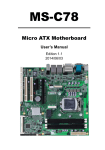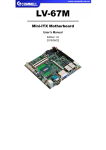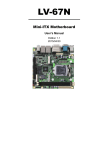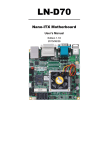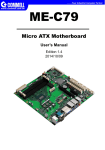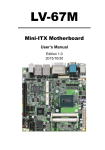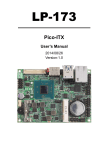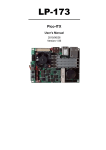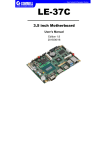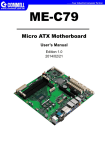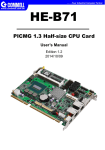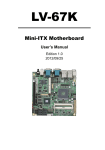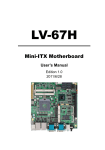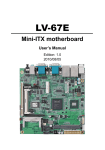Download User`s manual
Transcript
LV-67O Mini-ITX Motherboard User’s Manual Edition 1.64 2015/07/14 LV-67O User’s Manual Copyright Copyright 2014, all rights reserved. This document is copyrighted and all rights are reserved. The information in this document is subject to change without prior notice to make improvements to the products. This document contains proprietary information and protected by copyright. No part of this document may be reproduced, copied, or translated in any form or any means without prior written permission of the manufacturer. All trademarks and/or registered trademarks contains in this document are property of their respective owners. Disclaimer The company shall not be liable for any incidental or consequential damages resulting from the performance or use of this product. The company does not issue a warranty of any kind, express or implied, including without limitation implied warranties of merchantability or fitness for a particular purpose. The company has the right to revise the manual or include changes in the specifications of the product described within it at any time without notice and without obligation to notify any person of such revision or changes. Trademark All trademarks are the property of their respective holders. Any questions please visit our website at http://www.commell.com.tw TU UT Packing List: Please check the package content before you starting using the board. Hardware: LV-67O Mini-ITX Motherborad x 1 Cable Kit: SATA Cable x 2 OALSATA3-L / (1040529) Dual COM PORT Cable x 1 OALES-BKU2 / (1040087) (Option) USB2.0 Cable x 1 VGA Cable x 1 OALVGAN-S / (1040568) OALUSBA-1/ (1040172) (Option) -2- LV-67O User’s Manual I/O Shield x 1 OPLATE-MCDLA / (1270055) Power Cable x 1 OALATX-P3S2 / (1040058) DC Power Cable x 1 OALDC-A / (1040433) Printed Matters: Driver CD (Including User’s Manual) x 1 Cooler: Heat Sink: (OHS-P-M-7) / (2181010002) OHS-6 / (2181110008) LV-67OJIP, LV-67OJX2 LV-67OEIP, LV-67OEX2 LV-67ONIP, -3- LV-67ONX2 LV-67O User’s Manual Index Chapter 1 <Introduction> ..............................................................................5 1.1 <Product Overview>..................................................................................... 5 1.2 <Product Specification>................................................................................ 6 1.3 <Mechanical Drawing>................................................................................. 8 1.4 <Block Diagram>.......................................................................................... 9 Chapter 2 <Hardware Setup>........................................................................9 2.1 <Connector Location> .................................................................................. 9 2.2 <Jumper Location & Reference>................................................................ 10 2.3 <Connector Reference> ............................................................................. 11 2.3.1 <Internal Connectors> ................................................................... 11 2.4 < Memory and CFAST Setup> ................................................................... 12 2.4.1 <Memory Setup> ........................................................................... 12 2.4.2 < CFAST Setup >........................................................................... 12 2.5 <CMOS & ATX Setup> ............................................................................... 13 2.6 <Ethernet Interface>................................................................................... 14 2.7 <Onboard Display Interface> ..................................................................... 14 2.7.1 <Display>....................................................................................... 15 2.7.2 <LVDS> ......................................................................................... 15 2.7.3 <VGA Interface> ............................................................................ 18 2.8 <Integrated Audio Interface> ...................................................................... 19 2.9 <USB Interface>......................................................................................... 20 2.9.1 < USB 3.0 eXtensible Host Controller Driver install > .................... 20 2.10 <Serial Port> ............................................................................................ 24 2.11 <PCIE Mini Card and SIM Interface> ....................................................... 26 2.12 <GPIO and SMBUS Interface>................................................................. 28 2.13 <Power Supply and Fan Interface > ......................................................... 30 2.13.1 <Power Input> ............................................................................. 30 2.13.2 <Power Output>........................................................................... 31 2.13.3 <Fan connector>.......................................................................... 31 -4- LV-67O User’s Manual 2.14 <Switch and Indicator>............................................................................. 32 Chapter 3 <System Setup> .........................................................................33 3.1 <Audio Configuration>................................................................................ 33 3.2 <Display Properties Setting> ...................................................................... 34 3.3 <SATA configuration> ................................................................................. 36 Chapter 4 <BIOS Setup> .............................................................................36 Appendix A <I/O Port Pin Assignment>.....................................................37 A.1 <Serial ATA Port> ....................................................................................... 37 A.2 <LAN Port> ................................................................................................ 37 A.3 <LPC Port> ................................................................................................ 37 Appendix B <Flash BIOS> ..........................................................................38 B.1 <Flash Tool> .............................................................................................. 38 B.2 <Flash BIOS Procedure> ........................................................................... 38 Appendix C <Programming GPIO’s> .........................................................39 Appendix D <Programming Watchdog Timer > ........................................40 Contact Information.....................................................................................41 Chapter 1 <Introduction> 1.1 <Product Overview> LV-67O is the system-on-chip (SoC) designed for intelligent systems, delivering outstanding compute, graphical, and media performance while operating in an extended range of thermal conditions. These SoCs are based on the Silvermont microarchitecture, utilizing Intel’s industry-leading 22nm process technology with 3-D Tri-Gate transistors, which deliver significant improvements in computational performance and energy efficiency. New features for Intel® Celeron® and Atom Processor The Intel® Celeron® Processor J1900 / N2930 and Intel® Atom E3845 Processor supports, graphics, media performance, flexibility and more enhanced security that is suitable for a variety of intelligent systems the ideal choice. -5- LV-67O User’s Manual Outstanding integration of I/O interfaces Supports display interfaces with graphics processing, camera interfaces with image processing, audio with digital signal processing, multiple storage types, and legacy embedded I/O. Provides interface expansion capabilities through industry-standard high-bandwidth interfaces such as PCI Express* Gen 2.0, Hi-speed USB 2.0, and USB 3.0 connectivity. All in One multimedia solution Based on Intel® J1900 / N2920 /E3845 SoC, the board provides high performance onboard graphics, CRT, 24-bit dual channel LVDS interface, Display Port, DVI and two channels High Definition Audio, to meet the very requirement of the multimedia application. Flexible Extension Interface The board provides one PCIe mini slot and one SIM slot. 1.2 <Product Specification> General Specification Form Factor Mini-ITX motherboard CPU Intel® Processor J1900/N2930/E3845, package type FCBGA1170 Memory 2 x DDR3L (support 1.35V) 1066/1333 DIMM up to 8GB Real Time Clock Chipset integrated RTC with onboard lithium battery Watchdog Timer Generates a system reset with internal timer for 1min/s ~255min/s Power Management Supports ACPI 5.0 compliant Serial ATA Interface 2 x serial ATA interface with 300MB/s(3Gb/s) transfer rate (1 x CFast and 1 x SATAII is for option) VGA Interface Intel® Clear Video integrated HD Graphics Technology DVI Interface Onboard DVI connector. (DVI and LVDS1 can’t be enabled simultaneously) LVDS Interface 2 x Onboard 24-bit dual channel LVDS connector with +3.3V/+5V/+12V supply Display port Interface Onboard Display port connector. (Display port and LVDS2 can’t be enabled simultaneously) Audio Interface Realtek ALC262 High Definition Audio Codec -6- LV-67O User’s Manual LAN Interface 2 x Intel® I210 Gigabit LAN GPIO interface Onboard programmable 8-bit Digital I/O interface Extended Interface One PCIE X16 slot(Only support 1 Lane), 1 x PCIE Mini card or mSATA, 1 x SIM socket (CFast and mSATA can’t be enabled simultaneously) Internal I/O Port 4 x RS232, 1 x GPIO, 1 x Audio connector, 1 x SMBUS connector, 1 x CRT, 2 External I/O Port 1 x PS/2 Keyboard/Mouse Port, 1 x RS232, 1 x RS232/422/485, 1 x DVI port, x LVDS, 1 x LPC, 2 x USB 2.0(XHCI) and 2 x SATAII 1 x Display port, 2 x RJ45 LAN ports, 1 x USB 3.0(XHCI)/2.0(EHCI) port, 3 x USB 2.0 ports(EHCI). Power Requirement Standard 24-pin ATX power supply or 6~27V full range DC Input Dimension 170mm x 170mm Temperature Operating within 0~60 centigrade(for LV-67OJ and LV-67ON serial) Storage within -20~85 centigrade.(forLV-67OJ and LV-67ON serial) Operating within -40~85 centigrade(for LV-67OE serial) Storage within -40~85 centigrade.(for LV-67OE serial) Ordering Code LV-67OJIP Intel Celeron Processor J1900 (2M Cache, 2.42GHz), DVI, Display Port, CRT, Gigabit LAN, USB3.0 & 2.0, Serial Port, SATAII, Audio, PCIE Mini card, PCIE x16 (only support 1 Lane), SMBUS, GPIO, SIM, LPC, mSATA LV-67OEIP Intel Atom Processor E3845 (2M Cache, 1.91GHz), DVI, Display Port, CRT, Gigabit LAN, USB3.0 & 2.0, Serial Port, SATAII, Audio, PCIE Mini card, PCIE x16 (only support 1 Lane), SMBUS, GPIO, SIM, LPC, mSATA LV-67ONIP Intel Celeron Processor N2930 (2M Cache, 2.16GHz), DVI, Display Port, CRT, Gigabit LAN, USB3.0 & 2.0, Serial Port, SATAII, Audio, PCIE Mini card, PCIE x16 (only support 1 Lane), SMBUS, GPIO, SIM, LPC, mSATA LV-67OJX2 Intel Celeron Processor J1900 (2M Cache, 2.42GHz), 2 x LVDS, CRT, Gigabit LAN, USB3.0 & 2.0, Serial Port, SATAII, Audio, PCIE Mini card, PCIE x16 (only support 1 Lane), SMBUS, GPIO, SIM, LPC, mSATA LV-67OEX2 Intel Atom Processor E3845 (2M Cache, 1.91GHz), 2 x LVDS, CRT, Gigabit LAN, USB3.0 & 2.0, Serial Port, SATAII, Audio, PCIE Mini card, PCIE x16 (only support 1 Lane), SMBUS, GPIO, SIM, LPC, mSATA LV-67ONX2 Intel Celeron Processor N2930 (2M Cache, 2.16GHz), 2 x LVDS, CRT, Gigabit LAN, USB3.0 & 2.0, Serial Port, SATAII, Audio, PCIE Mini card, PCIE x16 (only support 1 Lane), SMBUS, GPIO, SIM, LPC, mSATA The specifications may be different as the actual production. For further product information please visit the website at http://www.commell.com.tw TU -7- UT LV-67O User’s Manual 1.3 <Mechanical Drawing> -8- LV-67O User’s Manual 1.4 <Block Diagram> Chapter 2 <Hardware Setup> 2.1 <Connector Location> -9 - LV-67O User’s Manual 2.2 <Jumper Location & Reference> Jumper JRTC JVLCD1 JVLCD2 JAT JP1 JP2 JCSEL1 JCSEL2 JVUSB JMSATA Function CMOS Operating/Clear Setting Panel1 Voltage Setting Panel2 Voltage Setting Power mode select Com1 Voltage Setting (For Pin 9) Com2 Voltage Setting (For Pin 9) COM2 RS-232 RS422 RS485 Setting USB Voltage Setting Mini Card mSATA Setting -10- LV-67O User’s Manual 2.3 <Connector Reference> 2.3.1 <Internal Connectors> Connector CPU SO-DIMM 1/2 SATAII 1/2 DC_IN ATX CN_AUDIO CDIN CN_DIO CN_USB 1 CPUFAN SYSFAN CN_CRT CN_LVDS 1/2 CN_INV 1/2 CN_COM 3/4/5/6 CN_LPC JFRNT PCIE Mini-PCIE SIMM JAT JSPD 1/2 JACT 1/2 Function FCBGA1170 CPU 204 -pin DDR3L SO-DIMM socket 7-pin Serial ATAII connector DC 6~27V input connector 24-pin power supply connector 5 x 2-pin audio connector 4-pin CD-ROM audio input connector 6 x 2-pin digital I/O connector 10-pin USB connector 4-pin CPU cooler fan connector 4-pin system cooler fan connector 16-pin VGA connector 20 x 2-pin LVDS connector 5-pin LCD inverter connector 9-pin RS232 5 x 2-pin LPC connector 14-pin front panel switch/indicator connector 164-pin x16 PCIE slot 52-pin Mini-PCIE socket 6-pin socket Power mode select LAN Speed LED connector LAN Activity LED connector -11- Remark LV-67O User’s Manual 2.3.2 <External Connectors> Connector USB_RJ45 1/2 DVI + Display port COM 1/2 PS/2 AUDIO Function 1x USB3.0 , 3 x USB2.0 , 2 x RJ45 LAN connector DVI connect and Display port connector Serial port connector PS/2 keyboard and mouse connector Audio connector Remark 2.4 < Memory and CFAST Setup> 2.4.1 <Memory Setup> LV-67O has two 204-pin DDR3L DIMM support up to 8GB of memory capacity and 1.35 Voltage. The memory frequency supports 1066/1333 MHz. Only Non-ECC memory is supported. If you install only one DDR3L memory module, please plug it into the SO-DIMM1 (top socket). 2.4.2 < CFAST Setup > The board provide one CFAST slot (optional) which supports SATA2 interface. The CFAST has the same size with CF card, but it shows higher efficiency and stability to transmit SATA signal. CFAST and mSATA can’t be used simultaneously CFAST plug close up -12- LV-67O User’s Manual Installing the CFAST in the back of the board. Note that the slot direction and fool-proofing design. Installation is complete 2.5 <CMOS & ATX Setup> The board’s data of CMOS can be setting in BIOS. If the board refuses to boot due to inappropriate CMOS settings, here is how to proceed to clear (reset) the CMOS to its default values. Jumper: JRTC Type: Onboard 3-pin jumper JRTC Mode 1-2 Clear CMOS 2-3 Normal Operation Default setting: 2-3 Jumper: JAT Type: onboard 3-pin jumper JAT Mode 1-2 AT Mode 2-3 ATX Mode Default setting:2-3 -13- LV-67O User’s Manual 2.6 <Ethernet Interface> The board integrates with two Intel I210 Gigabit Ethernet, as the PCI Express bus. The Intel I210 supports triple speed of 10/100/1000Base-T, with IEEE802.3 compliance and Wake-On-LAN supported. 2.7 <Onboard Display Interface> Based on Intel processor with built-in HD Graphic, the board provides one DVI connector & one Display port on real external I/O port, two 40-pin LVDS interface with 5-pin LCD backlight inverter connector and provides 16-pin VGA interface. The board provides dual display function with clone mode and extended desktop mode for DVI, Display port, VGA and LVDS. -14- LV-67O User’s Manual 2.7.1 <Display> Please connect your DVI & Display port or LCD monitor with male connector to the onboard female connector on rear I/O port . 2.7.2 <LVDS> The board provides two 40-pin LVDS connector for 18/24-bit single/dual channel panels, supports up to 1920 x 1080 resolution, with one LCD backlight inverter connector and two jumper for panel voltage setting. Please install LVDS cable before boot up. -15- LV-67O User’s Manual Effective patterns of connection: 1-2 / 3-4 / 5-6 Warning: others cause damage Connector: CN_INV Type: 5-pin LVDS Power Header Pin 1 2 3 4 5 Description +12V PWM GND GND ENABKL Connector: JVLCD Type: 6-pin Power select Header Pin Description 1-2 LCDVCC (3.3V) 3-4 LCDVCC (5V) 5-6 LCDVCC (12V) Default: 1-2 Connector: CN_LVDS Type: onboard 40-pin connector for LVDS connector Connector model: HIROSE DF13-40DP-1.25V or compatible Pin 2 4 6 8 10 12 14 16 18 20 22 24 26 28 30 Signal LCDVCC LVDS Detect (Note) ATX0ATX0+ GND ATX1ATX1+ GND ATX2ATX2+ GND ACLKACLK+ GND ATX3-16- Pin 1 3 5 7 9 11 13 15 17 19 21 23 25 27 29 Signal LCDVCC GND BTX0BTX0+ GND BTX1BTX1+ GND BTX2BTX2+ GND BTX3BTX3+ GND BCLK- LV-67O User’s Manual 32 ATX3+ 31 34 GND 33 36 DDCPCLK 35 38 DDCPDATA 37 40 N/C 39 Note: The LVDS Detect Pin please contact to the Panel GND. To setup the LCD, you need the component below: 1. A panel with LVDS interfaces. 2. An inverter for panel’s backlight power. 3. A LCD cable and an inverter cable. BCLK+ GND N/C N/C N/C For the cables, please follow the pin assignment of the connector to make a cable, because every panel has its own pin assignment, so we do not provide a standard cable; please find a local cable manufacture to make cables. LCD Installation Guide: 1. Preparing the LV-67O, LCD panel and the backlight inverter. 2. Please check the datasheet of the panel to see the voltage of the panel, and set the jumper JVLCD to +12V or +5V or +3.3V. 3. You would need a LVDS type cable. Panel side Board side For sample illustrator only 4. To connect all of the devices well. -17- LV-67O User’s Manual After setup the devices well, you need to select the LCD panel type in the BIOS. The panel type mapping is list below: BIOS panel type selection form (BIOS Version:1.0) Single / Dual channel Single / Dual channel NO. Output format NO. Output format 1 640 x 480 9 1680 x 1050 2 800 x 600 10 1920 x 1200 3 1024 x 768 11 1440 x 900 4 1280 x 1024 12 1600 x 900 5 1400 x 1050 13 1024 x 768 6 1400 x 1050 14 1280 x 800 7 1600 x 1200 15 1920 x 1080 8 1366 x 768 2.7.3 <VGA Interface> Connector: CN_CRT Type: onboard 16-pin connector for CN_CRT connector pitch 2.00mm Pin 1 3 5 7 9 11 13 15 Signal BR BB -CRTATCH IOGND1 NC NC 5HSYNC 5VCLK Pin 2 4 6 8 10 12 14 16 -18- Signal BG NC IOGND1 IOGND1 -CRTATCH 5VCDA 5VSYNC NC LV-67O User’s Manual 2.8 <Integrated Audio Interface> The board integrates onboard audio interface with REALTEK ALC262 code, with Intel next generation of audio standard as High Definition Audio, it offers more vivid sound and other advantages than former HD audio compliance. The main specifications of ALC262 are: z High-performance DACs with 100dB S/N ratio z 2 DAC channels support 16/20/24-bit PCM format for 2 audio solution z Compatible with HD z Meets Microsoft WHQL/WLP 2.0 audio requirements The board provides 2 channels audio phone jacks on rear I/O port, Line-in / MIC-in ports for front I/O panel through optional cable. -19- 2 10 LV-67O User’s Manual Connector: CN_AUDIO Type: 10-pin (2 x 5) header (pitch = 2.54mm) Pin 1 3 5 7 9 Description MIC_L MIC_R Speaker_R SENSE Speaker_L Pin 2 4 6 8 10 1 9 Description Ground N/C MIC Detect N/C Speaker Detect 2.9 <USB Interface> LV-67O integrates 1 x USB3.0 and 5 x USB2.0 , The specifications of USB3.0 are listed below: Interface USB3.0 Transfer Rate Up to 5Gb/s Voltage 5V The USB3.0 port need to Install USB 3.0 eXtensible Host Controller Driver and enable xHCI Mode. 2.9.1 < USB 3.0 eXtensible Host Controller Driver install > Step1. Copy the USB 3.0 driver from “Driver CD” to the local hard driver directory. ( Do not run this driver from a USB storage device) Step2. Configure default BIOS, click Advanced > South Cluster Configuration > USB Configuration, disable “EHCI Mode”. -20- LV-67O User’s Manual Step3. enable “xHCI Mode” and push “F10” to save configuration. Restart your computer. 1 Step4. If you enable xHCI Mode , USB 2.0 and USB 3.0 ports can’t use without drive. We recommend that you connect PS/2 mouse / keyboard installing USB 3.0 driver. Step5. Double click the “Setup.exe” from the directory. Click “Next” to continue. -21- LV-67O User’s Manual Step6. Lastly, the “Setup Complete” screen appears so click “Finish” to restart your computer. The specifications of USB2.0 are list: Interface Transfer Rate Voltage USB2.0 Up to 480Mb/s 5V -22- LV-67O User’s Manual Connector: CN_USB1 Type: 10-pin (2 x 5) header (pitch = 2.54mm) Pin 1 3 5 7 9 Description VCC (5V_SB/ 5V) Data0Data0+ Ground Ground Pin 2 4 6 8 10 Description VCC (5V_SB/ 5V) Data1Data1+ Ground N/C CN_USB1 need to enable xHCI Mode. Connector: JVUSB Type: 6-pin Power select jumper Pin Description 1-3 & 2-4 5V_SB 3-5 & 4-6 5V Default: 1-3 & 2-4 Effective patterns of connection: 1-3 & 2-4 or 3-5 & 4-6 Warning: others cause damages -23- LV-67O User’s Manual 2.10 <Serial Port> The board supports Three RS232 serial port and one jumper selectable RS232/422/485 serial ports. The jumper JCSEL1 & JCSEL2 can let you configure the communicating modes for COM2. Connector: COM1 Type: 9-pin D-sub male connector on bracket for COM1 Pin Description Pin Description 1 DCD 2 RXD 3 TXD 4 DTR 5 GND 6 DSR 7 RTS 8 CTS 9 RI 10 N/C Connector: COM2 Type: 9-pin D-sub male connector on bracket for COM2 Pin Description Pin Description 1 DCD/422TX-/4852 RXD/422TX+/485+ 3 TXD/422RX+ 4 DTR/422RX5 GND 6 DSR 7 RTS 8 CTS 9 RI 10 N/C Setting RS-232 & RS-422 & RS-485 for COM2 Connector: COM3/4, COM5/6 Type: 20-pin (2 x 10) header pitch = 2.54x1.27mm Pin Description Pin Description 1 DCD1 2 RXD1 3 TXD1 4 DTR1 5 GND1 6 DSR1 7 RTS1 8 CTS1 9 RI1 10 N/C 11 DCD2 12 RX2 13 TX2 14 DTR2 15 Ground 16 DSR2 -24- LV-67O User’s Manual 17 19 RTS2 RI2 18 20 CTS2 N/C Default setting: JCSEL1: (1-3, 2-4, 7-9, 8-10) JCSEL2: (1-2) Function JCSEL1 JCSEL2 RS-422 RS-485 RS-232 (Default) -25- LV-67O User’s Manual Jumper: JP1/JP2 (COM1/2) Type: onboard 6-pin header Power Mode JP1/2 Pin 9 with 5V Power 1-2 Pin 9 with 12V Power 3-4 Standard COM port 5-6 Default setting 2.11 <PCIE Mini Card and SIM Interface> The board provides a PCIE mini card sockets and a SIM socket. MINI_CARD is the Mini-PCIe slot for long size Mini-PCIe cards and supports mSATA. Connector: SIMM (3G MiniPcie Model) Type: 6-pin SIM socket Pin Description Pin Description 1 SIMVCC 2 SIMRST 3 SIMCLK 4 NC 5 GND 6 SIMVPP 7 SIMDATA Jumper: JMSATA -26- LV-67O User’s Manual Type: onboard 3-pin header MINI_CARD Mode JMSATA Supply mSATA 1-2 MINI_CARD 2-3 Default setting: 2-3 2.11.1 <SIM Setup> Step1. SIM card holder is marked by circle. Slide the cap toward OPEN direction. Step 2. Make sure that the cap is now at the OPEN position. Step 3. Flip the cap up for inserting a SIM card into. -27- LV-67O User’s Manual Step 4. Insert a SIM card as shown in the photo. Be sure that the corner cut is on top and the golden pads are up. Step 5. Now, flip down the cap as shown in the photo. Step 6. Press down and slide the cap to the CLOSE position. Be sure that the cap is tightly held with the socket. 2.12 <GPIO and SMBUS Interface> The board provides a programmable 8-bit digital I/O interface; you can use this general purpose I/O port for system control like POS or KIOSK. The GPIO is an Open-drain output and TTL-level input. 1. 2. Output:Open-drain, Most applications need use an external pull-up resistor. Input:TTL-level. DC characteristics: -28- LV-67O User’s Manual 5V TTL-level Input Pin Parameter Input Low Voltage Input High Voltage Input High Leakage Input Low Leakage Sym VIL VIH ILIH ILIL Min Typ Max 0.8 2.0 +10 -10 Unit V V μA μA Conditions VIN = 3.3V VIN = 0V Open-drain output pin with 12-mA sink capability Output Low Voltage VOL 0.4 Connector: CN_DIO Type: 12-pin (6 x 2) header (pitch = 2.0mm) Pin 1 3 5 7 9 11 Description Ground GPIO0 GPIO1 GPIO2 GPIO3 5V Pin 2 4 6 8 10 12 Connector: CN_SMBUS Type: 5-pin header for SMBUS Ports Pin 1 2 3 4 5 Description VCC N/C SMBDATA SMBCLK Ground -29- Description Ground GPIO4 GPIO5 GPIO6 GPIO7 12V V IOL = 12 mA LV-67O User’s Manual 2.13 <Power Supply and Fan Interface > 2.13.1 <Power Input> The board requires onboard 4-pin DC-input connector voltage range is from 6V to 27V, or onboard 24-pin ATX2.0. Connector: DC_IN Type: 4-pin standard Pentium 4 additional +12V power connector Pin Description Pin Description 1 Ground 2 Ground 3 +6V~+27V 4 +6V~+27V Connector: ATX Type: 24-pin ATX power connector PIN assignment 1 3.3V 2 3.3V 3 GND 4 5V 5 GND 6 5V 7 GND 8 PW_OK 9 5V_SB 10 12V 11 12V 12 3.3V 13 14 15 16 17 18 19 20 21 22 23 24 -30- 3.3V -12V GND -PSON GND GND GND N/C 5V 5V 5V GND LV-67O User’s Manual 2.13.2 <Power Output> The board provides one 24-pin ATX connector for +5V/+12V output for powering your HDD, CDROM or other devices. Attention: When DC-IN had power supplied, the ATX become output ! Avoid DC-IN and ATX power supply input at the same time ! Connector: ATX (When DC-IN be used) Type: 24-pin ATX connector for +5V/+12V Output PIN assignment 1 * 13 2 * 14 3 * 15 4 5V 16 5 GND 17 6 * 18 7 GND 19 8 * 20 9 * 21 10 12V 22 11 12V 23 12 * 24 * * * * * GND GND * * 5V 5V * Note: Maximum output voltage: 12V/2A & 5V/3A 2.13.3 <Fan connector> The board provides one 4-pin fan connectors supporting smart fan for CPU cooler and one 4-pin cooler fan connectors for system. -31- LV-67O User’s Manual Connector: CPUFAN Type: 4-pin fan wafer connector Pin Description 1 Ground 3 Fan Speed Detection Pin 2 4 Description +12V Fan Control Connector: SYSFAN Type: 4-pin fan wafer connector Pin Description 1 Ground 3 Fan Speed Detection Pin 2 4 Description +12V Fan Control 2.14 <Switch and Indicator> The JFRNT provides front control panel of the board, such as power button, reset and beeper, etc. Please check well before you connecting the cables on the chassis. Connector: JFRNT Type: onboard 14-pin (2 x 7) 2.54-pitch header Function IDE LED Signal PIN Signal HDLED+ 1 2 PWRLED+ HDLED- 3 4 N/C Reset+ 5 6 PWRLED- Reset- 7 8 SPK+ N/C 9 10 N/C PWRBT+ 11 12 N/C PWRBT- 13 14 SPK- Function Power LED Reset Speaker Power Button -32- LV-67O User’s Manual Chapter 3 <System Setup> 3.1 <Audio Configuration> The board integrates REALTEK® ALC262 code. It can support 2-channel sound under system configuration. Please follow the steps below to setup your sound system. 1. Install REALTEK HD Audio driver. 2. Lunch the control panel and Sound Effect Manager. 3. Select Speaker Configuratio -33- LV-67O User’s Manual 3.2 <Display Properties Setting> Based on Intel J1900/N2930/E3845 with HD Graphic, the board supports two DACs for display device as different resolution and color bit. Please install the Intel Graphic Driver before you starting setup display devices. 1. Click right button on the desktop to lunch Screen resolution > Advanced settings 2. Click Graphics Properties… button for more specificity setup. -34- LV-67O User’s Manual Click Graphics Properties... for advanced setup 3. This setup options can let you define each device settings. 4E -35- LV-67O User’s Manual 3.3 <SATA configuration> SATA Mode: This option can let you select whether the Serial ATA hard drives would work under normal IDE or AHCI. Chapter 4 <BIOS Setup> The motherboard uses the Phoenix BIOS for the system configuration. The Phoenix BIOS in the single board computer is a customized version of the industrial standard BIOS for IBM PC AT-compatible computers. It supports Intel x86 and compatible CPU architecture based processors and computers. The BIOS provides critical low-level support for the system central processing, memory and I/O sub-systems. The BIOS setup program of the single board computer let the customers modify the basic configuration setting. The settings are stored in a dedicated battery-backed memory, NVRAM, retains the information when the power is turned off. If the battery runs out of the power, then the settings of BIOS will come back to the default setting. The BIOS section of the manual is subject to change without notice and is provided here for reference purpose only. The settings and configurations of the BIOS are current at the time of print, and therefore they may not be exactly the same as that displayed on your screen. To activate CMOS Setup program, press <DEL> key immediately after you turn on the system. The following message “Press DEL to enter SETUP” should appear in the lower left hand corner of your screen. When you enter the CMOS Setup Utility, the Main Menu will be displayed as Figure 4-1. You can use arrow keys to select your function, press <Enter> key to accept the selection and enter the sub-menu. -36- LV-67O User’s Manual Figure 4-1 CMOS Setup Utility Main Screen Appendix A <I/O Port Pin Assignment> A.1 <Serial ATA Port> Connector: SATA1/2 Type: 7-pin wafer connector 1 2 3 4 5 67 71 GND RSATA_TXP1 RSATA_TXN1 GND RSATA_RXN1 RSATA_RXP1 GND A.2 <LAN Port> Connector: RJ45 Type: RJ45 connector with LED on bracket Pin Description 8 1 2 3 4 5 MI0+ MI0- MI1+ MI2+ 6 MI2- MI1- 7 8 MI3+ MI3- A.3 <LPC Port> Connector: CN_LPC Type: 10-pin header for LPC Port Pin 1 3 5 7 Description LPC_CLK -LFRAME LAD2 LAD0 Pin 2 4 6 8 -37- 1 Description RESETLAD3 LAD1 +3.3V LV-67O User’s Manual 9 11 SERIRQ 3.3V 10 12 Ground N/C Appendix B <Flash BIOS> B.1 <Flash Tool> The board is based on Phoenix BIOS and can be updated easily by the BIOS auto flash tool. You can download the tool online from below link http://www.commell.com/Support/Product%20Technical%20Support/LV-67O. htm B.2 <Flash BIOS Procedure> 1.Extract the zip file(re-flash tool and BIOS file) to root of the USB flash drive. 2.Insert your USB flash drive in USB port of the board and power on the system. 3. Boot to EFI-Shell mode (UEFI Boot Enable, Legacy Boot Disable) -38- LV-67O User’s Manual then input the “fs0:” command to switch to the root of the USB flash drive. 4. Type the ” fpt64.efi -y -f xxx.bin” command to start flash BIOS processes. ( xxx.bin means the BIOS file that you want to update) 5. When it finished all update processes, restart the system. Any question about the BIOS re-flash please contact your distributors or visit the web-site at below: http://www.commell.com.tw/support/support.htm UT Appendix C <Programming GPIO’s> The GPIO’ can be programmed with the MSDOS debug program using simple IN/OUT commands. The following lines show an example how to do this. (The GPIO is open drain) GPIO0…..GPIO7 bit0……bit7 -o 4E 87 ;enter configuration -o 4E 87 -o 4E 07 -o 4F 07 ;enale GPIO function -o 4E 30 -o 4F 10 ;enable GPIO configuration -o 4E F0 -o 4F xx ;set GPIO as input/output; set ‘1’ for input,’0’for output -o 4E F1 -o 4F xx ;if set GPIO’s as output,in this register its value can be set -39- LV-67O User’s Manual Optional : -o 4E F2 -o 4F xx ; Data inversion register ; ‘1’ inverts the current valus of the bits ,’0’ leaves them as they are -o 4E 30 -o 4F 01 ; active GPIO’s For further information, please refer to NCT6106D datasheet. Appendix D <Programming Watchdog Timer > The watchdog timer makes the system auto-reset while it stops to work for a period. The integrated watchdog timer can be setup as system reset mode by program. Timeout Value Range - 1 to 255 - Second or Minute Program Sample The integrated Watchdog Timer can be set up by programming. Enter configuration -O 4E 87 -O 4E 87 -O 4E 07 -O 4F 08 -O 4E 30 -O 4F 01 -O 4E F0 -O 4F 00 -O 4E F1 -O 4F 0A Logic Device Enable WDT Enable Set as Second* Set reset time 10 Sec -40- LV-67O User’s Manual You can select Timer setting in the BIOS, after setting the time options, the system will reset according to the period of your selection. Contact Information Any advice or comment about our products and service, or anything we can help you please don’t hesitate to contact with us. We will do our best to support you for your products, projects and business. Taiwan Commate Computer Inc. 19F., No.94, Sec. 1, Xintai 5th Rd., Xizhi Dist., New Taipei Address City 22102, Taiwan TEL +886-2-26963909 FAX +886-2-26963911 http://www.commell.com.tw Website TU UT [email protected] (General Information) TU UT E-Mail [email protected] (Technical Support) TU Facebook Twitter UT https://www.facebook.com/pages/Taiwan-Commate-Computer-Inc/547993955271899 https://twitter.com/Taiwan_Commate Commell is a brand name of Taiwan commate computer Inc. -41-









































